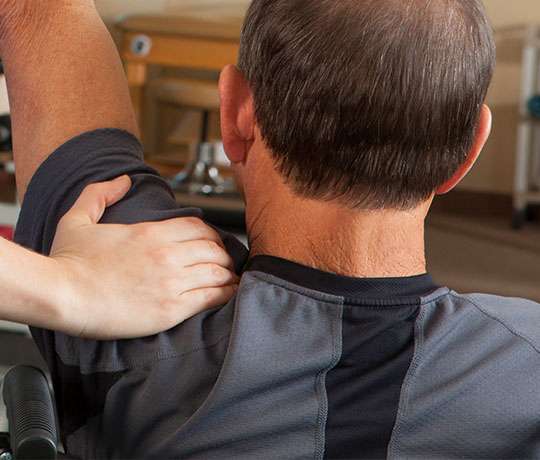While there are a number of treatments available for plantar fasciitis, many do not provide satisfactory results for the patient and some have undesirable side effects. Shockwave therapy has been shown to be a safe and effective treatment for plantar fasciitis.
What is plantar fasciitis?
Plantar fasciitis is a common cause of plantar heel pain in patients. It is a condition where the plantar fascia ligament becomes irritated, inflamed, thickened and very painful. The plantar fascia is a strong and fibrous structure that runs along the base of the foot, connecting the heel bone to the toes at the ball of the foot. Its purpose is to assist with distributing forces and weight as a person walks, and to support the arch of the foot.
Plantar fasciitis is usually the result of overuse or repetitive strain on the plantar fascia ligament. It occurs most commonly in females, middle aged people, people whose occupations require them to be standing for extended periods of time, those with either flat feet or high arches, and people who engage in a lot of running and walking.
Plantar fasciitis causes a characteristic sharp, hot, stabbing pain at the plantar aspect of the heel (the part where the ligament attaches to the heel bone). Most commonly, patients report the pain is worse in the mornings as they get out of bed, or after a period of rest.
What is shockwave therapy?
Shockwave therapy (also known as extracorporeal shockwave therapy, ESWT) is a treatment that is used across many medical fields. Using a hand-held probe, the sports podiatrist directs high energy sound waves into the patient’s affected area that is requiring treatment. The energy promotes tissue healing and regeneration, stimulates blood flow to the area, and provides the patient with almost instant pain relief.
What are the benefits of shockwave therapy for plantar fasciitis treatment?
Clinical studies have demonstrated shockwave therapy to be an effective treatment for plantar fasciitis. It is a treatment that is championed by many medical professionals including sports podiatrists, because of its efficacy and safety with lack of side effects. Numerous studies have documented the reduction in the thickness of the plantar fascia with chronic plantar fasciitis1,2, which is indicative of healing. A number of studies have also determined that shockwave therapy is an effective treatment in reducing pain for plantar fasciitis sufferers2,3,4. It is a non-invasive treatment and one which can be conveniently performed in-clinic during your consultation with your sports podiatrist.
Is shockwave therapy for plantar fasciitis painful?
Whilst some patients experience slight pressure or discomfort, the treatment is not generally painful. Given that shockwave therapy only usually lasts for around five minutes a session, most patients are able to tolerate it quite well. You should communicate any discomfort to your sport podiatrist as they also have the ability to reduce the intensity of the treatment, and increase it gradually over the course of your shockwave therapy sessions as you become more tolerant.
How many sessions of shockwave therapy for plantar fasciitis are required?
Since the effect of shockwave therapy is cumulative, you will need more than one. Most patients have between three to six sessions, however sometimes more are required depending on the severity and complexity of a condition. Most patients do however experience some pain relief after just one session. Your sports podiatrist will advise you as to how many sessions you will require and what the frequency of these will be. Sessions are usually around a week apart for treatment of plantar fasciitis.
Readers are advised that the information regarding shockwave therapy for plantar fasciitis treatment that is detailed above is for educational purposes only and should not be taken as general medical advice. If you have been diagnosed with plantar fasciitis or wish to discuss the potential benefits of shockwave therapy for your condition, you should make an appointment with a qualified sports podiatrist. Appointments can be made online at https://sydneyheelpain.com.au/book-online/ or by phoning (02) 93883322.
Further reading and references
1Vahdatpour, B., Sajadieh, S., Bateni, V., Karami, M., Sajjadieh, H., (2012), Extracorporeal shock wave therapy in patients with plantar fasciitis. A randomized, placebo-controlled trial with ultrasonographic and subjective outcome assessments, Journal of Research in Medical Sciences, 17(9), 834-838.
2Hammer, D. S., Adam, F., Kreutz, A., Rupp, S., Kohn, D., Seil, R., (2005), Ultrasonographic evaluation at 6-month follow-up of plantar fasciitis after extracorporeal shock wave therapy, Archives of Orthopaedic and Trauma Surgery, 125(1), 6-9.
3Lou, J., Wang, S., Liu, S., Xing, G., (2017), Effectiveness of extracorporeal shockwave therapy without local anaesthesia in patients with recalcitrant plantar fasciitis: a meta-analysis of randomized controlled trials, American Journal of Physical Medicine and Rehabilitation, 96(8), 529-534.
4Agil, A., Siddiqui, M. R., Solan, M., Redfern, D. J., Gulati, V., Cobb, J. P., (2013), Extracorporeal shock wave therapy is effective in treating chronic plantar fasciitis: a meta-analysis of RCTs, Clinical Orthopedics and Related Research, 471(11), 3645-3652.
Written by Karl Lockett

Share on Pinterest
Getty Images/Masego Morulane
Plantar fasciitis is an inflammation of the plantar fascia, which is a band of tissue that runs along the bottom of your foot and connects your heel bone to your toes. This condition can cause heel pain that’s often more severe or noticeable in the morning.
Traditional treatments for plantar fasciitis include rest, physical therapy, and medication — but in recent decades, shock wave therapy has emerged as a treatment option.
Shock wave therapy uses high levels of targeted acoustic energy to promote healing and reduce pain. It’s noninvasive and may help people with plantar fasciitis avoid more extensive treatments like surgery. But the treatment doesn’t work for everyone and the results can be unpredictable.
Read on to learn more about what the research says about the efficacy of shock wave therapy, how the procedure works, and what to expect from the results.
How does shock wave therapy for plantar fasciitis work?
In shock wave therapy, a healthcare professional will apply penetrating waves of ultrasound energy to an inflamed area of your body, creating microtrauma in that area. This microtrauma prompts a healing response in your body.
In response to shock wave therapy, the body can:
- Create new blood vessels that bring more blood and nutrition to the inflammation.
- Receive hyperstimulation of nerve endings, resulting in immediate pain reduction.
- Break down calcifications.
- Increase cell permeability for increased healing.
Shock wave treatment is noninvasive and can dramatically lessen pain and other plantar fasciitis symptoms. This makes it an ideal alternative for people who may not want to take medication or receive invasive surgical treatments.
A small 2021 study suggests that shock wave therapy is an effective treatment for plantar fasciitis. The researchers found that four sessions of shock wave therapy helped reduce the thickness of the plantar fascia. It also reduced symptoms of inflammation in the area.
Procedure for shock wave therapy for plantar fasciitis
Shock wave therapy is noninvasive, meaning it happens on the outside of your body. It is performed on an outpatient basis, so you’ll be able to go home once your procedure is complete.
There aren’t generally any specific steps you need to take before a shock wave procedure. But you’ll likely be receiving local anesthesia or a sedative, so it’s a good idea to have someone else take you to and from your appointment.
Once you arrive at the facility for your treatment, here’s what you can typically expect from the procedure:
- You’ll be asked to remove your socks and shoes.
- You’ll lie flat on a cushioned table, with your stomach down and your legs supported by a pillow.
- You’ll receive either a sedative or local anesthesia in your heels so that you don’t feel pain during the procedure.
- You’ll have ultrasound gel applied to your heels.
- A technician will use a specialized probe to deliver compressed air shock waves to your heels.
The procedure takes about 10 to 20 minutes per foot.
You might feel some mild discomfort as the shock waves penetrate your heel. Depending on the severity of your plantar fasciitis pain, you may need to return for two to four additional shock wave sessions.
How effective is shock wave therapy?
In general, shock wave therapy is thought to provide some symptom relief for about 44% to 80% of people who receive this treatment.
Shock wave therapy for plantar fasciitis is generally considered an effective treatment, according to a 2021 study. Yet the wide range of results shows that it may not work for everyone.
Shock wave therapy is associated with a rapid decrease in pain, a small 2020 study suggests. Data from multiple studies indicates that shock wave therapy — especially focused shock wave therapy (FSW) and extracorporeal shock wave therapy (ESWT) — is most effective at reducing symptoms, according to 2017 research.
And many people with plantar fasciitis who’ve received shock wave therapy report experiencing a dramatic decrease in pain — case studies confirm many of these experiences.
Yet there have not been any large-scale studies to back up these findings and anecdotes. Studies about the lasting effects of shock wave therapy years after treatment are inconclusive.
A 2018 case-series study indicates that shock wave therapy in combination with other treatments might be more effective than shock wave therapy alone. For example, combining physical therapy and shock wave treatment may promote long-term, sustainable healing.
What are the pros and cons of shock wave therapy?
Shock wave therapy has many possible benefits, but it’s not the best solution for everyone.
Some of the benefits of shock wave therapy include that it:
- is a noninvasive treatment with minimal preparation and recovery needed
- resolves pain quickly
- is considered safe
- has a lower risk of complications than medication or surgical treatments
- can help people with plantar fasciitis avoid unnecessary surgery
Some of the downsides of shock wave therapy that you should consider include:
- It’s not effective for everyone.
- You may need multiple treatments over time to see significant results.
- Many insurance companies don’t cover shock wave therapy.
- Treatments can be expensive without insurance coverage.
- Complications can include temporary pain, bruising, swelling, and numbness.
How much does shock wave therapy cost for plantar fasciitis?
A survey of multiple medical practices suggests that the cost to receive shock wave therapy for plantar fasciitis without insurance coverage averages around $1,000.
The exact cost for shock wave therapy can depend on:
- the type of shock wave therapy a doctor or specialist recommends
- the treatment facility you choose
- the number of sessions you need
- your geographical location
- your health insurance coverage
Health insurance doesn’t always cover shock wave therapy for plantar fasciitis. Check with your insurance provider before you make an appointment to receive shock wave therapy treatments.
What are other treatment options for plantar fasciitis?
Shock wave therapy isn’t the only option for plantar fasciitis. Many other treatment options are available for this painful condition.
The right treatment for you depends on the severity of your symptoms and how you respond to treatment. Some common treatment options include:
- Lifestyle changes: Simple lifestyle modifications like rest and avoiding activities that cause pain can help symptoms resolve in just a few months. If your pain is severe, crutches or a walking boot can help keep you from placing your full weight on your feet while your inflammation lessens over time.
- Ice: Applying ice to the inflamed area can help reduce pain and swelling.
- Medication: A doctor might recommend nonsteroidal anti-inflammatory drugs (NSAIDs) to help relieve pain and reduce swelling. Over-the-counter NSAIDs can help treat mild pain, while prescription NSAIDs can help with more severe or chronic pain.
- Physical therapy: Physical therapy can help you gain muscle strength and flexibility that can promote healing as well as reduce pain.
- Splints: A doctor or physical therapist might advise you to wear a splint at night to support your foot and reduce motion that can worsen swelling or pain.
- Arch supports: Wearing arch supports in your shoes can help relieve plantar fasciitis pain.
- Injections: Steroid injections can deliver medication directly to your heel for fast pain relief. The relief you get from these injections is temporary, so you may need to receive injections every few months to help relieve pain if you have chronic inflammation.
- Ultrasonic tissue repair: Ultrasonic tissue repair uses ultrasound to guide a needle into your heel. The needle breaks up damaged tissue, and the damaged tissue is removed from your body.
- Surgery: In severe cases of plantar fasciitis, surgery might be necessary to detach damaged tissue from the bone.
The takeaway
Shock wave therapy can help some people with plantar fasciitis reduce pain. This technique has been in use for over two decades, and studies suggest that it can be an effective treatment.
But not everyone with plantar fasciitis will experience relief from this treatment, and shock wave treatment for plantar fasciitis isn’t covered by most health insurance plans.
Talk with a doctor if you have plantar fasciitis and are curious about shock wave treatment — they can help you decide if it makes sense as a treatment for you.



